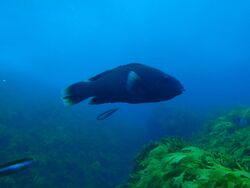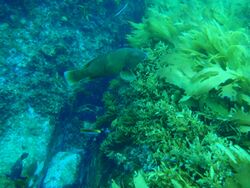Biology:Achoerodus gouldii
| Achoerodus gouldii | |
|---|---|

| |
| Achoerodus gouldii male | |
| Scientific classification | |
| Domain: | Eukaryota |
| Kingdom: | Animalia |
| Phylum: | Chordata |
| Class: | Actinopterygii |
| Order: | Labriformes |
| Family: | Labridae |
| Genus: | Achoerodus |
| Species: | A. gouldii
|
| Binomial name | |
| Achoerodus gouldii (J. Richardson, 1843)
| |

| |
| Dark blue = western blue groper | |
| Synonyms | |
| |
The western blue groper (Achoerodus gouldii) is a species of wrasse native to coastal waters of southern Australia from the Houtman Abrolhos in Western Australia to west of Melbourne.
This species prefers areas with rocky substrates and can be found at depths of from 1 to 65 m . Their diet consists of other fishes, crabs, lobster, various molluscs including abalone, and starfish. This species grows to a length of 175 cm (69 in).[2] Weights of up to 40 kg (88 lb) have been recorded.[3] They have a single long-based dorsal fin, a large squarish tail, thick fleshy lips, large heavy scales and peg-like teeth.[4] This species is of minor importance to local commercial fisheries.[2]
In South Australia the species is protected in Spencer Gulf, St Vincent Gulf, INvestigator Strait and Backstairs Passage.[5] The species is occasionally caught by line and spear fishers. Conservationists and some scientists argue that state-wide protection is needed to achieve ecologically meaningful results.[citation needed] It is considered by many experts[who?] to be functionally extinct in Gulf Saint Vincent and mature adults are now rare in Spencer Gulf[citation needed]. In light of the fact that it's the top order territorial bony rocky reef fish in this State[citation needed], full protection should[according to whom?] be a matter of high priority.
Outside of spatial closures, recreational fishers are allowed to catch one Western blue groper per day in South Australia[5] and Western Australia.[6] The fish is fully protected in Victorian waters.[7]
Etymology
The species was formally described by the naturalist John Richardson in 1843 from a specimen taken to the British Museum (Natural History) by John Gould,[8] who Richardson honoured in the specific name he gave to this fish.[4]
References
- ↑ Choat, J.H.; Gillanders, B.; Pollard, D. (2010). "Achoerodus gouldii". IUCN Red List of Threatened Species 2010: e.T187520A8556943. doi:10.2305/IUCN.UK.2010-4.RLTS.T187520A8556943.en. https://www.iucnredlist.org/species/187520/8556943. Retrieved 20 November 2021.
- ↑ 2.0 2.1 Froese, Rainer and Pauly, Daniel, eds. (2013). "Achoerodus gouldii" in FishBase. August 2013 version.
- ↑ Fisheries Western Australia - Western Blue Groper Fact Sheet
- ↑ 4.0 4.1 Dianne J. Bray (2018). "Achoerodus gouldii". Fishes of Australia. Museums Victoria. http://www.fishesofaustralia.net.au/home/species/206.
- ↑ 5.0 5.1 Department of Primary Industries and Regions, South Australia (2016-11-30). "Western Blue Groper" (in en-au). https://pir.sa.gov.au/fishing/fishing_limits/western_blue_groper.
- ↑ "Groper, western blue - Western Australian recreational fishing rules". http://rules.fish.wa.gov.au/Species/Index/66.
- ↑ Authority, Victorian Fisheries (2020-05-12). "Blue Groper" (in en-AU). https://vfa.vic.gov.au/recreational-fishing/recreational-fishing-guide/catch-limits-and-closed-seasons/types-of-fish/marine-and-estuarine-scale-fish/blue-groper.
- ↑ Richardson, J. (1843). Contributions to the ichthyology of Australia (continued). Annals and Magazine of Natural History (New Series). 11. pp. 22–28, 169–182, 352–359, 422–428. https://www.biodiversitylibrary.org/page/2326177#page/380/mode/1up.
External links
Wikidata ☰ Q935046 entry
 |



